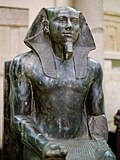Great Sphinx

The Great Sphinx is at Giza near Cairo in Egypt. It sits in a depression to the south of the pyramid of the Pharaoh Khafre (Chephren) at the west bank of the Nile River. The Sphinx is a stone sculpture of a creature with a human head and a lion's body. The greatest monumental sculpture in the ancient world, its body is 200 feet (60m) long and 65 feet (20m) tall. Its face is 13 feet (4m) wide.
It is the oldest known monumental sculpture in Egypt. It is thought to have been built by ancient Egyptians of the Old Kingdom in the reign of the Pharaoh Khafre (c. 2558–2532 BC).[1]
The Great Sphinx does not appear in any known inscription of the Old Kingdom. There are no inscriptions anywhere describing its construction or its original purpose. In the New Kingdom, the Sphinx was called Hor-em-akhet (English: Horus of the Horizon), and the pharaoh Thutmose IV (1401–1391 or 1397–1388 BC) referred to it in his "Dream Stele".
The purpose of the Sphinx is not known. Some archaeologists assume that it was a memorial to a Pharaoh or that it functioned as some sort of talisman or guardian god. Other scholars believe the Sphinx as an astronomical observation device that marked the position of the rising sun on the day of the spring equinox in the time of Leo the Lion.
The statue is eroding today because of wind and humidity and the smog from Cairo. Attempts to restore it have often caused more harm than good. Present attempts at restoration are under the control of the Supreme Council of Antiquities' archaeologists. They are working to drain away underground water.
Great Sphinx Media
Before being defaced, the Great Sphinx bore the face of Pharaoh Khafre, the builder of the Second Pyramid at Giza
Natural rock formation at Farafra, Egypt
The New Kingdom Dream Stele between the paws of the Sphinx, 2009
The Sphinx by Beniamino Facchinelli, c. 1885
Limestone fragments of the Sphinx's beard in the British Museum, 14th century BC









